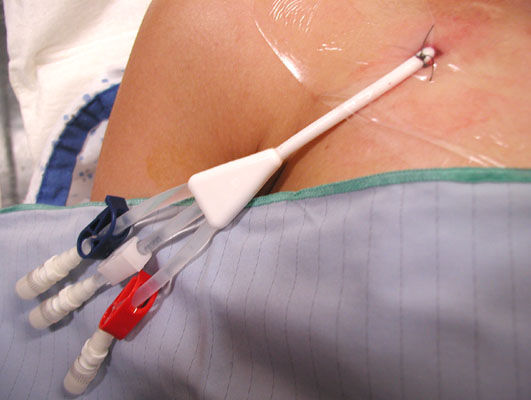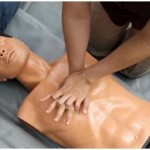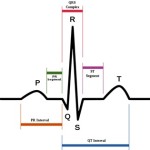Central line procedure is use in all kinds of emergency situations. Central line is tiny tube that is placed in a vein for long-term during therapy or kidney dialysis. With central line is much easier to give drugs for a long period of time or you can use it for kidney dialysis. With central line is easier and less painful than having needles put in your veins each time you need therapy.
The central line procedure is performed in an X-ray room by a radiologist and specially trained nurses and technologists. The radiologist will place a small tube in the vein under your shoulder bone and anchor it by making a small tunnel under your skin. The tube can stay in place as long as you need it for dialysis or drug treatment.
- Hemodynamic pressure monitoring
- Large-bore intravenous access
- Infusion of therapeutic drugs
- Plasmapheresis, apheresis
- Renal dialysis
- Transvenous pacing
- Aspiration of air embolism
<< Back to Medical Nursing Videos
Central Line And Central Venous Catheter Videos
Videos on
this site are for entertainment purposes only. Please
do not attempt any of the procedures seen in these videos
without formal medical education & licensing.
What type of central line do you need?
The triple lumen catheter: There are three lumens in this relatively thin and long catheter. It is actually set up as a tube, with in a tube, with in a tube. Each tube has its separate ivy connection port and all this tubes come out in separate holes at the distal line of the catheter. This is a perfect solution for those patients that require multiple medications that are not compatible with each other. The triple lumen catheter is ideal from the septic patient. We cannot use the triple lumen catheter for infusion of large volumes of crystalloid or blood products and trauma patients.
The cordis catheter: Unlike the triple lumen catheter the cordis catheter can be placed in a half of time, which is relatively quickly. You can use it for large amont of fluids in short period of time. This catheter is short and fat and has only one lumen. The cordis catheter is used when large volumes’ of crystalloid of blood products are needed and it is ideal for GL bleeders, trauma patients, resuscitations or CODE situations. If you are in emergent situation place a Cordis catheter first. You will not make a mistake. The convenience of this catheter is that you can place the triple lumen catheter into the cordis catheter as well as pacemaker and all the other things that you need.
The trauma line– this line is lot less common than the triple lumen catheter and the cordis catheter. It is a short, fat catheter that you can use for infusion of large amount of valium in short amount of time. This type of catheter is used only for trauma patients.
What do you need for central line procedure?
If you have a stable patient first you need to check if you have everything set up:
- Central line Kit
- Skin cleanser
- Chlorapep (chlorhexadine)
- Line Flush
- Sterile Gloves
- Extra Lidocain
- Extra 10-12cc syringe
- Large Tegaderm/Opsite (IV site cover)
This list can be change if your patient is not stable. For not stable patients most of our practitioners use a bottle of Betedine, sterile gloves and central line kit.
Where you can perform a central venous placement?
Central venous line placement is typically performed at four sites in the body: the right or left internal jugular vein, or the right or left subclavian vein. Alternatives include the external jugular and femoral veins. A long catheter may be advances into the central circulation from the antecubital veins as well.
The internal jugular vein follows a line from the inferior aspect of the external; acoustic meatus to the media aspect of the clavicle. It goes deep to the sternocleidomastoid muscle between the two heads and joints the subclavian vein to form the brachiocephalic vein, posterior to the closest of the sternum.
Central venous catheterization via the jugular vein has a lower incidence of pneumothorax compared to catheterization via the subclavian vein, and it can be easily compressed after catheter removal of after unintentional arterial puncture. Ultrasound is very convenient and valuable for IJV cannulation, it’s convenience is because the incidence of anatomical variants may be as high as 8, 5%. Subclavian vein catheterization is more comfortable for awake patients and less prone to contamination from respiratory secretions, particularly with tracheotomies.
Complications:
- Minor hematoma
- Local infection
- Arterial puncture
- Arrhythmia























